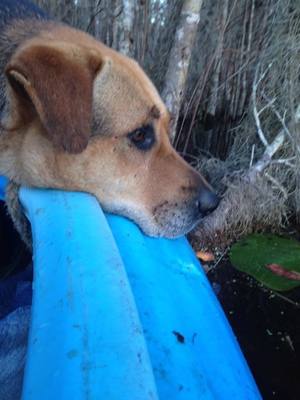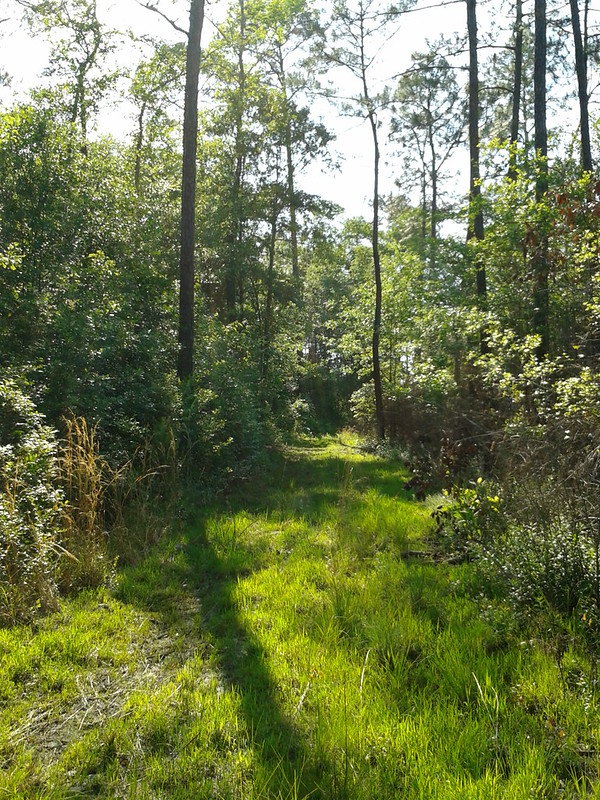A nice May evening at the pond with dogs in boats.
 Except it was December.
Gretchen posted these
facebook pictures reposted below; click on any small picture to see a larger one.
See also a few more pictures
by jsq.
-jsq
Except it was December.
Gretchen posted these
facebook pictures reposted below; click on any small picture to see a larger one.
See also a few more pictures
by jsq.
-jsq
Tag Archives: grass
Greenway
Native plants in your yard for native wildlife
 Nature is not something
out there, apart from people.
It never was, and nowadays people have built and farmed and clearcut
so much that wildlife species from insects to birds are in trouble.
In south Georgia people may think that our trees make a lot of wildlife habitat.
Actually, most of those trees are planted pine plantations with
very limited undergrowth, and in town many yards are deserts of grass
plus exotic species that don’t support native birds.
Douglas Tallamy offers one solution:
turn yards into wildlife habitat by growing native species.
Since we are as always remodeling nature, we might as well do it
so as to feed the rest of nature and ourselves,
and by the way get flood prevention and possibly cleaner water as well,
oh, and fewer pesticides to poison ourselves.
Nature is not something
out there, apart from people.
It never was, and nowadays people have built and farmed and clearcut
so much that wildlife species from insects to birds are in trouble.
In south Georgia people may think that our trees make a lot of wildlife habitat.
Actually, most of those trees are planted pine plantations with
very limited undergrowth, and in town many yards are deserts of grass
plus exotic species that don’t support native birds.
Douglas Tallamy offers one solution:
turn yards into wildlife habitat by growing native species.
Since we are as always remodeling nature, we might as well do it
so as to feed the rest of nature and ourselves,
and by the way get flood prevention and possibly cleaner water as well,
oh, and fewer pesticides to poison ourselves.
Douglas Tallamy makes a clear and compelling case in
 Bringing Nature Home: How You Can Sustain Wildlife with Native Plants
Bringing Nature Home: How You Can Sustain Wildlife with Native Plants
…it is not yet too late to save most of the plants and animals that sustain the ecosystems on which we ourselves depend. Second, restoring native plants to most human-dominated landscapes is relatively easy to do.
Some of you may wonder why native species are so important? Don’t we have more deer than we can shoot? Maybe so, but we have far fewer birds of almost every species than we did decades and only a few years ago.
Some may wonder: aren’t exotic species just as good as native ones,
if deer and birds can eat them?
Actually, no, because many exotic species are poisonous
 to native wildlife, and because invasive exotics crowd out natives
and reduce species diversity.
From kudzu to
Japanese climbing fern, exotic invasives are bad for wildlife
and may also promote erosion and flooding by strangling native vegetation.
to native wildlife, and because invasive exotics crowd out natives
and reduce species diversity.
From kudzu to
Japanese climbing fern, exotic invasives are bad for wildlife
and may also promote erosion and flooding by strangling native vegetation.
All plants are not created equal, particularly in their ability to support wildlife. Most of our native plant-eaters are not able to eat alien plants, and we are replacing native plants with alien species at an alarming rate, especially in the suburban gardens on which our wildlife increasingly depends. My central message is that unless we restore native plants to our suburban ecosystems, the future of biodiversity in the United States is dim.
Tallamy had an epiphany when he and his wife moved to 10 acres in Pennsylvania in 2000:
Continue readingRabbit munching grass on the driveway

 As Gretchen walked out one day,
As Gretchen walked out one day,
A rabbit was eating grass like hay:
Rabbit munching grass on the driveway
Lowndes County, Georgia, 24 May 2012
Video by Gretchen Quarterman for Okra Paradise Farms.
-jsq
Beef: Grass-fed versus Grain-fed
Well, I guess if you’re used to the taste of CAFO beef. To me, who was raised on beef from cows in the field, grass-fed beef tastes like beef, and CAFO beef tastes like cardboard.Could a grass-fed cut, with its lower-fat content, rival a grain-fed cut? Yes: It was succulent, buttery, and robust, with a perfectly caramelized crust. The juices formed a simple, rich sauce.
Is it better for you?
Grass-fed beef is lower in calories, contains more healthy omega-3 fats, more vitamins A and E, higher levels of antioxidants, and up to seven times the beta-carotene.Does it cost more? Yes, but in my experience I don’t need to eat a lot of it to feel full and get the taste. Your experience may vary.
Perhaps the most interesting part is that this article is in a mass-market magazine. Which also gives tips on how to source your own local grass-fed beef. And has a facebook page.
Or come to Valdosta Farm Days and get your local beef there.
-jsq
PS: This post owed to Lindsey.

